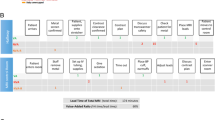Abstract
The Improve phase aims to identify ways to improve the outcomes of the process and system and minimize the variation throughout the system. In other words, the Improve phase aims for the identification and development of multiple alternatives for increasing performance and for selecting and implementing best alternative/s for improvement. The Six Sigma team focuses on specific changes that may have the desired impacts on the relevant processes by redesigning the process, eliminating NVA activities and wastes, and testing them using such methods as simulation, optimization, Design of Experiment (DOE), lean implementation, and Failure Modes and Effects Analysis (FMEA).
Access this chapter
Tax calculation will be finalised at checkout
Purchases are for personal use only
Similar content being viewed by others
References
Ahmed, A., Page, J., and J. Olsen. (2017). Process improvement based on an integrated approach of DMAIC and multi-method simulation. The 22nd international congress on modelling and simulation, Hobart, Tasmania, 3–8thDecember 2017.
Altiparmak, F., Dengiz, B., & Bulgak, A. A. (2002). Optimization of buffer sizes in assembly systems using intelligent techniques. In Proceedings of the Winter Simulation Conference (Vol. 2, pp. 1157–1162). IEEE.
Dağsuyu, C., Göçmen, E., Narlı, M., & Kokangül, A. (2016). Classical and fuzzy FMEA risk analysis in a sterilization unit. Computers & Industrial Engineering, 101, 286–294.
Fattahi, R., & Khalilzadeh, M. (2018). Risk evaluation using a novel hybrid method based on FMEA, extended MULTIMOORA, and AHP methods under fuzzy environment. Safety Science, 102, 290–300.
Hussein, N. A., Abdelmaguid, T. F., Tawfik, B. S., & Ahmed, N. G. (2017). Mitigating overcrowding in emergency departments using Six Sigma and simulation: A case study in Egypt. Operations Research for Health Care, 15, 1–12.
ISO 3534-3. Statistics — Vocabulary and symbols —Part 3: Design of experiments. ISO.
Karnon, J., Stahl, J., Brennan, A., Caro, J. J., Mar, J., & Möller, J. (2012). Modeling using discrete event simulation: A report of the ISPOR-SMDM modeling good research practices task force–4. Medical Decision Making, 32(5), 701–711.
King, B. (1989). Hoshin planning: The developmental approach. Salem: GOAL/QPC.
Liu, H. C. (2016). FMEA using uncertainty theories and MCDM methods. In FMEA using uncertainty theories and MCDM methods (pp. 13–27). Singapore: Springer.
Montgomery, D. C. (2013). Introduction to statistical quality. New York: Wiley/NYC.
Ricki G. I. (2008). Introduction to simulation. Proceedings of the 2008 Winter Simulation Conference.
Shannon, R. E. (1975). Systems simulation – The art and science. Englewood Cliffs: Prentice-Hall.
Shingo, S. (1985). Zero quality control: Source inspection and the Poka-Yoke System. Massachusetts: Productivity Press.
Stewart, D. M., & Grout, J. R. (2001). The human side of mistake-proofing. Production and Operations Management, 10(4), 440–459.
Taneja, M., & Manchanda, A. (2013). Six sigma an approach to improve productivity in manufacturing industry. International Journal of Engineering Trends and Technology (IJETT), 5(6), 281–286.
Ungureanu, D., Sisak, F., Kristaly, D. M., & Moraru, S. (2005). Simulation modeling. Input data collection and analysis. In The 14th international scientific and applied science conference electronics ET, Sozopol, Bulgaria: 43–50.
Further Readings
Greasley, A. (2017). Simulation modelling for business. London, UK: Routledge.
Monden, Y. (1998). Toyota production system, an integrated approach to just-in-time. Norcross: Engineering and Management Press.
Montgomery, D. C. (2017). Design and analysis of experiments. New York: Wiley.
Morgan, B. J. (2018). Elements of simulation. Milton: Routledge.
Myers, R. H., Montgomery, D. C., & Anderson-Cook, C. M. (2016). Response surface methodology: Process and product optimization using designed experiments. Hoboken: Wiley.
Author information
Authors and Affiliations
Corresponding author
Rights and permissions
Copyright information
© 2020 The Author(s)
About this chapter
Cite this chapter
Pakdil, F. (2020). Improve Phase: I Is for Improve. In: Six Sigma for Students. Palgrave Macmillan, Cham. https://doi.org/10.1007/978-3-030-40709-4_10
Download citation
DOI: https://doi.org/10.1007/978-3-030-40709-4_10
Publisher Name: Palgrave Macmillan, Cham
Print ISBN: 978-3-030-40708-7
Online ISBN: 978-3-030-40709-4
eBook Packages: Business and ManagementBusiness and Management (R0)



